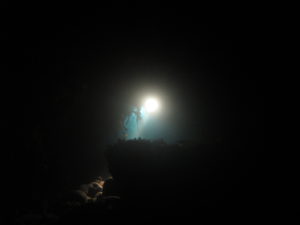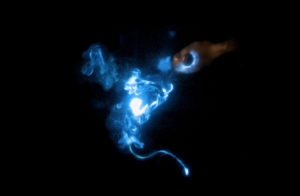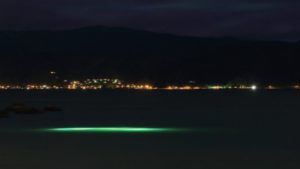
Hot chocolate by torch light, with just a hint of sea water – that’s what night diving is all about! Winter is on its way and with it so are night dives. I have always found night dives to be the most incredible way to spend time underwater. Rather than being dark and gloomy like so many people assume, night dives are bright, vibrant and exciting! That same old dive site you have been to a million times is completely different once the sun sets. The fish you see change, shadows make the landscape more dramatic and things that are seemingly inactive during the day come to life. Despite one or two challenges presented by the dark for me there is nothing not to love about night dives.
 I have lost count of how many people I have taken for their first night, but almost all of them have for just a moment been shaking in their little dive boots. I get it though! I think we are all inherently afraid of the dark, or at least of what we can not see so it makes sense to be a little apprehensive. But any experienced night diver will tell you there is really nothing to worry about once you have had a little basic training. There are two ways to introduce yourself to night diving either through the PADI Advanced Open Water course or the PADI Night Diver Specialty. The Advanced Open Water Night Dive is really just a taster. With an instructor you will go through the basics of communicating, navigating and sticking with you buddy in the dark. This is a great way to bring you up to speed on night diving; but for those of you think night diving is the best kind of diving the specialty is for you. The specialty covers handling light failure, lost buddy procedure, navigation, identification of nocturnal species and dive planning. I think if you’re considering conducting night dives independently the specialty really is the way to go.
I have lost count of how many people I have taken for their first night, but almost all of them have for just a moment been shaking in their little dive boots. I get it though! I think we are all inherently afraid of the dark, or at least of what we can not see so it makes sense to be a little apprehensive. But any experienced night diver will tell you there is really nothing to worry about once you have had a little basic training. There are two ways to introduce yourself to night diving either through the PADI Advanced Open Water course or the PADI Night Diver Specialty. The Advanced Open Water Night Dive is really just a taster. With an instructor you will go through the basics of communicating, navigating and sticking with you buddy in the dark. This is a great way to bring you up to speed on night diving; but for those of you think night diving is the best kind of diving the specialty is for you. The specialty covers handling light failure, lost buddy procedure, navigation, identification of nocturnal species and dive planning. I think if you’re considering conducting night dives independently the specialty really is the way to go.
It is completely counterintuitive to think that a dive a night, in the dark could be more vibrant than during the day but it is 100% true. We learn in our open water course that as we dive deeper red light dissipates the deep we go, and one way to compensate for this is to use an underwater torch. Well

how often do you use you dive light during a dive in the day? If you’re anything like me use of a dive light during the day is pretty well limited to looking down into holes and cracks. So imagine your entire dive being lit buy a powerful torch. The reds in fish, seaweed, corals, and rocks pop out and the dramatic contrast of colour come to life. But even if your light fails and you are immersed in darkness the vibrancy of our underwater world shines through with bioluminescence – the production and emission of light from a biological source. That’s right, when your light goes out the sea will provide you with some natural lights of its own. Imagine the stars twinkling at your fingertips, or a field of fireflies fleeing your presence. That is bioluminescence. Tiny organisms in the water emit small pulses of light as a defence mechanism to ward off predators or in some instances attract prey. Either way witnessing bioluminescence is one of the most magical experiences you can have underwater.

Bioluminescence isn’t the only thing we can expect to be different at night. A lot of the fish we see during the day have made their beds in the kelp and the night guard crawls out for an appearance. Invertebrates are king at night, you can expect to see crabs and crayfish roaming about freely while fish like spotties have burrowed into a nest of sorts in the sand. Moki pull on pajamas and have distinct strips only visible at night and butter fish sleep with one eye open and their tails wrapped securely into the weed.
Most of the time even dive sites look and feel completely different. With your vision limited to only what your light illuminates it can be easy to swim past key landmarks and end up in what feels like a new part of an old site, but in reality is exactly where you normally go. One of my all time favourite night dives was on the Mikhail Lermontov. I had already made plenty of dives on this incredible wreck and felt like i had a pretty good sense of direction. I clearly remember though as I was following along the decrepit and warped deck having a profound sense of having not explored this part of the wreck. There were steps leading down to what looked like previously unnoticed rooms and cabins. But all that came to an abrupt end when i realised I was swimming through the Davits (arms that hold life rafts in place), an area which i had been diving only a few hours ago in the light! My point is even old sites can feel new at night.
key landmarks and end up in what feels like a new part of an old site, but in reality is exactly where you normally go. One of my all time favourite night dives was on the Mikhail Lermontov. I had already made plenty of dives on this incredible wreck and felt like i had a pretty good sense of direction. I clearly remember though as I was following along the decrepit and warped deck having a profound sense of having not explored this part of the wreck. There were steps leading down to what looked like previously unnoticed rooms and cabins. But all that came to an abrupt end when i realised I was swimming through the Davits (arms that hold life rafts in place), an area which i had been diving only a few hours ago in the light! My point is even old sites can feel new at night.
 Obviously the dark does present a few unique challenges too. It is more or less inevitable that you will stand on an unseen sharp rock while climbing into your wetsuit. I guarantee you will get confused about what direction to head at least once – just remember to TRUST YOUR COMPASS. Chances are you will end up leaving something like a glove or catch bag on the shore before the dive as you couldn’t find it when you did your buddy check. All of these are just minor frustrations and should never hold you back from night diving. One of the more interesting challenges of night diving is identifying your entry and exit point. But we have a cunning plan to make this easier. To identify our entry/exit we often use two lights at different heights, in the same line but separated by 10m or so. With this setup all we need to do to identify our exit is while we are out in the water keep swimming until the lights line up. Once they do, all you need to keep them inline and swim towards the lights. A simple, easy and effective way to solve what is a pretty considerable challenge for some dive sites.
Obviously the dark does present a few unique challenges too. It is more or less inevitable that you will stand on an unseen sharp rock while climbing into your wetsuit. I guarantee you will get confused about what direction to head at least once – just remember to TRUST YOUR COMPASS. Chances are you will end up leaving something like a glove or catch bag on the shore before the dive as you couldn’t find it when you did your buddy check. All of these are just minor frustrations and should never hold you back from night diving. One of the more interesting challenges of night diving is identifying your entry and exit point. But we have a cunning plan to make this easier. To identify our entry/exit we often use two lights at different heights, in the same line but separated by 10m or so. With this setup all we need to do to identify our exit is while we are out in the water keep swimming until the lights line up. Once they do, all you need to keep them inline and swim towards the lights. A simple, easy and effective way to solve what is a pretty considerable challenge for some dive sites.
For me nothing beats surfacing in the middle of a bay in the dead of night, with city lights shimmering on the surface and stars glinting in the sky above. Top that off with a crisp sea breeze and a mug of hot chocolate and you’re in for a great night. I can’t wait to get into this season of night diving and hopefully you come out and join me.
Paddy.